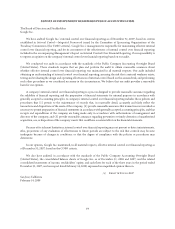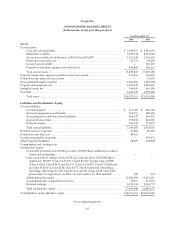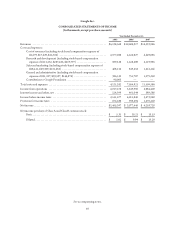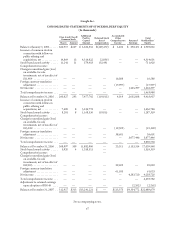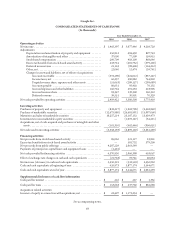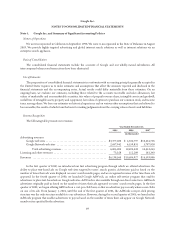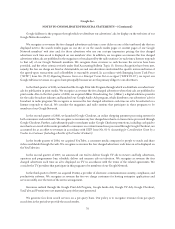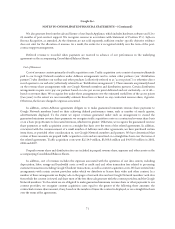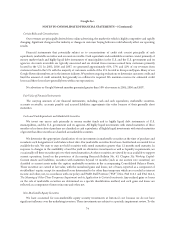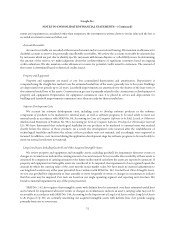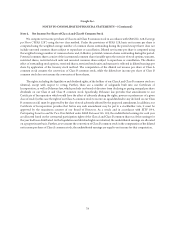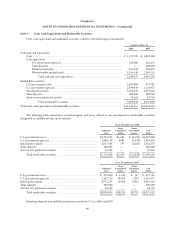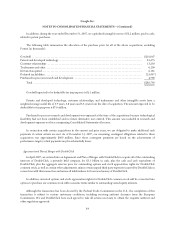Google 2007 Annual Report Download - page 88
Download and view the complete annual report
Please find page 88 of the 2007 Google annual report below. You can navigate through the pages in the report by either clicking on the pages listed below, or by using the keyword search tool below to find specific information within the annual report.Google Inc.
NOTES TO CONSOLIDATED FINANCIAL STATEMENTS—(Continued)
Certain Risks and Concentrations
Our revenues are principally derived from online advertising, the market for which is highly competitive and rapidly
changing. Significant changes in this industry or changes in customer buying behavior could adversely affect our operating
results.
Financial instruments that potentially subject us to concentrations of credit risk consist principally of cash
equivalents, marketable securities and accounts receivable. Cash equivalents and marketable securities consist primarily of
money market funds and highly liquid debt instruments of municipalities in the U.S. and the U.S. government and its
agencies. Accounts receivable are typically unsecured and are derived from revenues earned from customers primarily
located in the U.S. In 2005, 2006 and 2007, we generated approximately 61%, 57% and 52% of our revenues from
customers based in the U.S. with the majority of customers outside of the U.S. located in Europe and Japan. Many of our
Google Network members are in the internet industry. We perform ongoing evaluations to determine customer credit and
limit the amount of credit extended, but generally no collateral is required. We maintain reserves for estimated credit
losses and these losses have generally been within our expectations.
No advertiser or Google Network member generated greater than 10% of revenues in 2005, 2006 and 2007.
Fair Value of Financial Instruments
The carrying amounts of our financial instruments, including cash and cash equivalents, marketable securities,
accounts receivable, accounts payable and accrued liabilities, approximate fair value because of their generally short
maturities.
Cash and Cash Equivalents and Marketable Securities
We invest our excess cash primarily in money market funds and in highly liquid debt instruments of U.S.
municipalities, and the U.S. government and its agencies. All highly liquid investments with stated maturities of three
months or less from date of purchase are classified as cash equivalents; all highly liquid investments with stated maturities
of greater than three months are classified as marketable securities.
We determine the appropriate classification of our investments in marketable securities at the time of purchase and
reevaluate such designation at each balance sheet date. Our marketable securities have been classified and accounted for as
available-for-sale. We may or may not hold securities with stated maturities greater than 12 months until maturity. In
response to changes in the availability of and the yield on alternative investments as well as liquidity requirements, we
occasionally sell these securities prior to their stated maturities. As these securities are viewed by us as available to support
current operations, based on the provisions of Accounting Research Bulletin No. 43, Chapter 3A, Working Capital-
Current Assets and Liabilities, securities with maturities beyond 12 months (such as our auction rate securities) are
classified as current assets under the caption marketable securities in the accompanying Consolidated Balance Sheets.
These securities are carried at fair value, with the unrealized gains and losses, net of taxes, reported as a component of
stockholders’ equity, except for unrealized losses determined to be other than temporary which are recorded as interest
income and other, net, in accordance with our policy and FASB Staff Position (“FSP”) Nos. FAS 115-1 and FAS 124-1,
The Meaning of Other-Than-Temporary Impairment and its Application to Certain Investments. Any realized gains or losses
on the sale of marketable securities are determined on a specific identification method, and such gains and losses are
reflected as a component of interest income and other, net.
Non-Marketable Equity Securities
We have accounted for non-marketable equity security investments at historical cost because we do not have
significant influence over the underlying investees. These investments are subject to a periodic impairment review. To the
74


